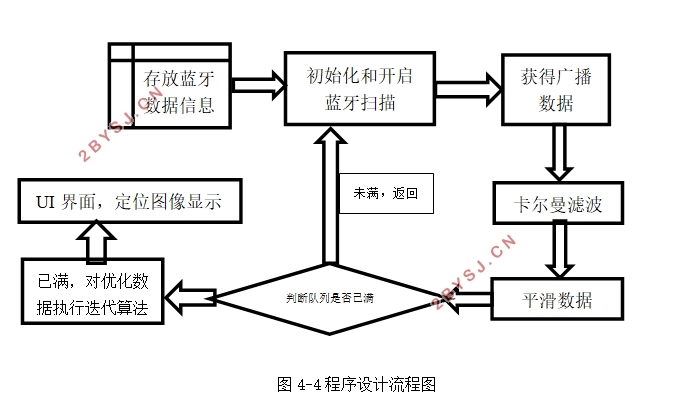基于BLE的室内定位系统设计
无需注册登录,支付后按照提示操作即可获取该资料.
基于BLE的室内定位系统设计(论文12000字)
摘要:室内定位系统的研究设计近几年开始发展,国内外先后利用各种无线通信技术进行室内定位方法的研究。但是,高成本、高功耗以及对环境和外设的高要求,使得这些系统无法生活化地推广使用。近几年,蓝牙技术在传输距离、功耗等各项技术指标方面取得较大进展,现在智能手机都支持蓝牙功能,所以可结合智能手机实现室内定位。
本文研究内容为基于低功耗蓝牙(Bluetooth Low Energy,BLE)接收信号强度指示(Received Signal Strength Indicator,RSSI)的室内定位技术,并结合安卓智能手机进行了应用程序APP的调试。
关键词:室内定位;BLE;安卓系统;智能手机;RSSI
Design of Indoor Positioning system based on BLE
Abstract:The research and design of indoor positioning system has been developed in recent years. Various wireless communication technologies have been used to study indoor positioning methods at home and abroad. However, high cost, high power consumption and high requirements for environment and peripherals make these systems impossible to be popularized. In recent years, Bluetooth technology has made great progress in the transmission distance, power consumption and other technical indicators. Now smart phones support Bluetooth function, so it can be combined with smart phones to achieve indoor positioning.
This paper focuses on indoor positioning technology based on low power Bluetooth Low Energy,BLE ,Received Signal Strength Indicator, RSSI, and debugs the application program APP with Android smartphone.
Key words:indoor location;BLE;Android;smartphone; RSSI

目录
第一章 绪论 1
1.1 研究背景及意义 1
1.2 国内外研究现状 1
1.3 论文研究内容 2
1.4 论文组织结构 3
第二章 无线室内定位技术 4
2.1 常见短距离低功耗通信技术 4
2.1.1超声波定位技术 4
2.1.2 室内GPS定位技术 4
2.1.3 RFID定位技术 4
2.1.4 近场通信(NFC) 4
2.1.5 红外线定位技术 5
2.1.6 超宽带(UWB)技术 5
2.1.7 WiFi定位技术 5
2.1.8 ZigBee技术 5
2.1.9 蓝牙室内定位技术 6
2.2 室内定位算法 7
2.2.1 测距算法 7
2.2.2 基于测距的定位算法 7
第三章 BLE室内定位系统设计方案及实现技术 9
3.1 研究目标 9
3.2 BLE室内定位设计实现的相关技术 9
3.2.1 定位的实现 9
3.2.2 测距功能的实现 10
3.2.3 iBeacon的应用 10
3.2.4 数据优化的实现 11
3.3 BLE室内定位系统设计方案 13
3.3.1 整体设计 12
3.3.2 硬件选择 12
3.3.3软件设计 13
第四章 室内定位系统软件设计 14
4.1 软件开发环境的搭建 14
4.2 低功耗蓝牙的协议栈及规范 15
4.3 系统软件程序的设计 15
第五章 定位结果和误差分析 18
5.1 定位结果 18
5.1.1实验步骤 18
5.1.2实验数据 18
5.2 误差分析 20
第六章 总结和展望 22
6.1 总结 22
6.2 展望 22
参考文献 23
致谢....25
